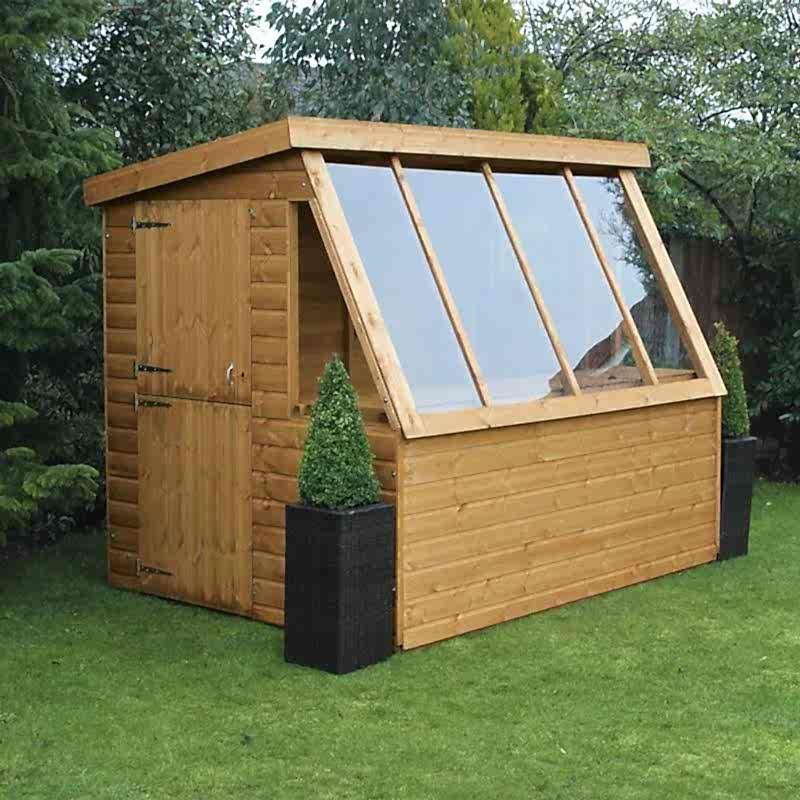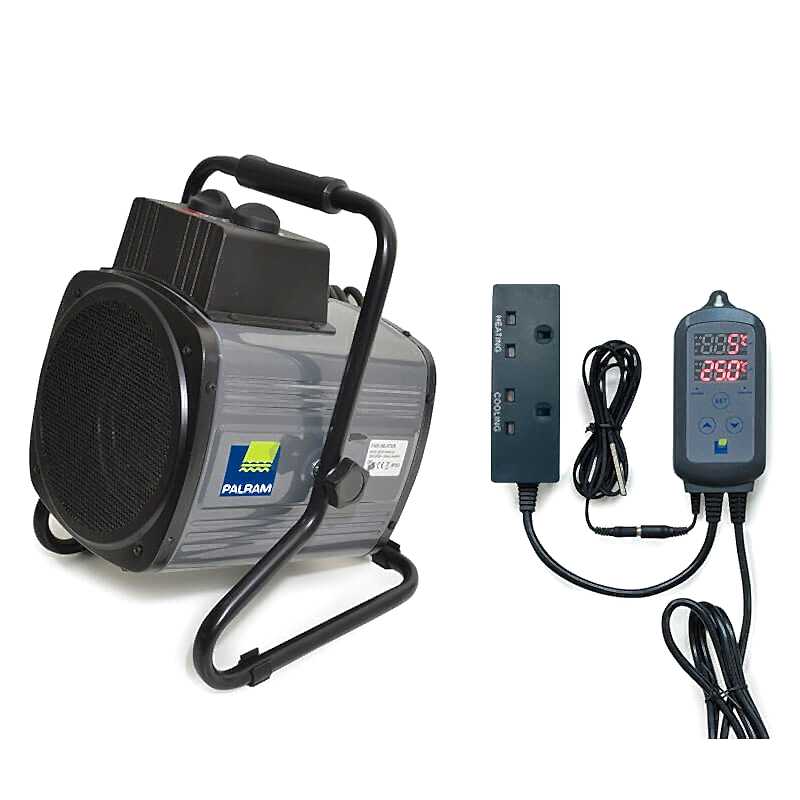Greenhouse Buying Guide
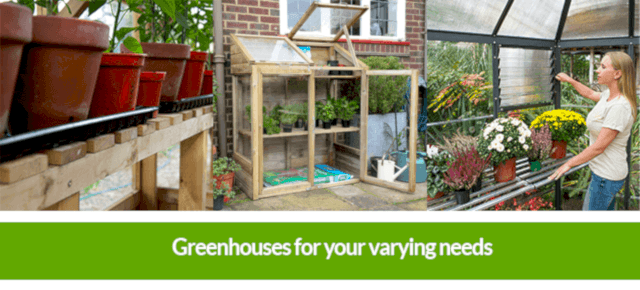

If you are a keen gardener or looking to flex your green fingers for the first time, understanding different greenhouse types alongside the importance of a high-quality greenhouse is an essential garden purchase. A greenhouse can extend your growing season, providing you with the optimum conditions in which to nurture your own vegetables, fruits, and plants.
So, what are the best greenhouses to consider? Follow our greenhouse buying guide to learn more about what to look for when buying a greenhouse.
The topics outlined in this greenhouse guide can be read below. Click on a topic to access the specific information you require.
How to choose a greenhouse
1. Welcome to greenhouse gardening
3. Advantages and disadvantages of greenhouses
5. How to choose a greenhouse for beginners
6. Great innovative greenhouse ideas
7. Key decisions in choosing a greenhouse
8. What is the cost of a greenhouse?
9. Planning permission for greenhouses
11. Delivery on our greenhouses for sale
Welcome to greenhouse gardening
Are you considering purchasing a greenhouse? We can see why you should be, as a greenhouse can significantly enhance your gardening enjoyment. A greenhouse allows you to grow a wide selection of plants such as vegetables, fruits, herbs and flowers throughout the year. Imagine growing plants irrespective of the external weather conditions, even in the UK.
This greenhouse buying guide will equip you with all the information you need about how to choose a greenhouse that perfectly meets your needs.
What is a greenhouse?
A greenhouse is a garden building, usually constructed from glass or clear plastic (frequently polycarbonate), that grows and safeguards plants. A greenhouse lets sunlight in and retains warmth, it creates a micro climate inside that is much warmer than the external temperature. This is perfect for the often cold UK-climate and enables the cultivation of plants in optimal conditions that might otherwise be impossible outside. Greenhouses are frequently used to nurture a variety of plants including fruits, vegetables, herbs, flowers and even exotic plants such as orchids.
Advantages and disadvantages of greenhouses
We now analyse some of the main advantages and disadvantages of greenhouses.
Advantages of greenhouses
Enjoy the following greenhouse benefits when you invest in this garden building:
- 1. All-year crops - benefit from all-year-round crops as greenhouses protect delicate plants from harsher periods of UK weather
- 2. Controllable growing environment - gardeners can tailor and fine-tune internal greenhouse conditions to perfectly suit plant growth. For instance, during the chilly winter months in the UK, it is entirely possible to cultivate warm-weather crops like peppers and strawberries that require plenty of sunlight and warmth
- 3. Eco-friendly - protect the plant by adopting sustainable living practices. Save on electricity costs and buy food locally to reduce transportation pollution, all this overall leads to a much-reduced carbon footprint, which is good for you and the planet
- 4. Educational benefits - greenhouses are an excellent resource for gardening newbies. They provide a practical learning environment for both budding and seasoned gardeners to gain insights into both plant cultivation and sustainable practices
- 5. Enhanced efficiency in crop yields - the greenhouse microclimate leads to increased crop yields. Think of quicker and larger crop harvests! This is why many businesses growing fruit and vegetables use huge greenhouses for the cultivation of commercial crops in the winter (e.g. cucumbers, and lettuce, etc.)
- 6. Grow a wide selection of plants - the sky is the limit; grow whatever plants you like! If you have ever fancied growing species such as ornamental plants, tropical species, etc., this is made possible!
- 7. Grow plants without soil - also called hydroponics. Greenhouses can be used for this purpose to cultivate crops without soil. This sounds futuristic but is possible today if plants are given optimal oxygen, nutrients and water levels
- 8. Natural heating - greenhouses generate warmth naturally without the need for energy from electrical sources. This makes them a cost-effective solution in terms of energy efficiency
- 9. Nurturing environment - even better than potting sheds, a greenhouse is a nurturing environment. They are perfect for germinating seeds, as well as growing on seedlings and cuttings
- 10. Optimal light conditions - greenhouse design optimises light conditions. The science of refraction means that rays from sunlight are spread efficiently across the greenhouse. This means wherever a plant is within the greenhouse it will receive good light, which is essential for healthy growth
- 11. Pest protection - reduce pest issues, such as rodents, slugs, snails and even cats and dogs! These can all cause issues in various ways to garden plants. A greenhouse environment reduces crop losses and eliminates the need to use pest-controlling chemicals (e.g. slug killer)
- 12. Reduced plant disease levels - the ability to create an adjusted greenhouse microclimate reduces disease levels. This is due to a combination of controlled air flow, humidity management and temperature regulation. Greenhouses are a closed environment, which reduces the opportunity for diseases from wild plants and weeds to spread. Also, insect and bug-originating diseases are significantly reduced
- 13. Water conservation - some greenhouses feature integrated watering systems that optimise water usage and reduce wastage. This makes them perfect for supporting an environmentally friendly and sustainable way of life
Greenhouse disadvantages
To be entirely fair, there are some greenhouse disadvantages, which we discuss below:
- 1. Immobility - once in place, some greenhouses are difficult to move, and may be prone to breakages if moved
- 2. Maintenance - greenhouse gardening involves higher maintenance than open air gardening. Cleaning of windows and internal surfaces (e.g. glass or polycarbonate) is important. There is also a need for ongoing watering (unless automated watering methods are available)
- 3. Manual climate control - unfortunately, most greenhouses in the UK do not come equipped with automatic climate control systems as a standard feature. For manual greenhouse gardeners, managing climate control, therefore becomes an additional task. Irksome rather than difficult, managing climate control (e.g. humidity, lighting, temperature, ventilation, etc.) can be time-consuming
- 4. Pest control - pest issues are generally lower, but some pests and diseases are more prevalent in greenhouses, these will need to be monitored
- 5. Pollinator shortage - greenhouses sometimes suffer from a pollinator shortage. Insects such as bees, butterflies and wasps naturally pollinate in the garden, but find it difficult to get into closed greenhouses. This might make it difficult to pollinate plants, which are dependent on pollinators for harvests (e.g. crops like cucumbers, strawberries, tomatoes, etc.) Greenhouse gardeners are likely to need to develop some strategies for introducing pollinators into the greenhouse
- 6. Space availability - some gardens are not large enough to sustain the size of a greenhouse. Small greenhouses are available, which may reduce the space issue
- 7. Upfront cost of a greenhouse - naturally open gardening is FREE, whereas a greenhouse comes at a cost. Although relatively modest for smaller manual greenhouses, the costs can stack up for large greenhouses with advanced greenhouse features such as climate control, etc.
Greenhouse designs
We must thank the Romans and Emperor Tiberius specifically for the first greenhouses. The Romans wanted cucumbers and other seasonal fruits and vegetables all-year round and developed greenhouses for this purpose. That was 2,000 years ago and greenhouse technology was not widely adopted until around the seventeenth century. This was when voyagers around the world brought back tropical plant species, which needed a greenhouse to stay alive.
Moving onto the 21st century, there are a myriad of greenhouse design options to choose from at Buy Fencing Direct with 220+ greenhouse models. We discuss greenhouse sizes in detail later, you can choose from cold frames, small greenhouses to large greenhouses and sunrooms. Here are some greenhouse designs to consider:
- Combi greenhouse sheds - these are a hybrid model and have a greenhouse with a side shed attached for additional storage
- Hexagonal-shaped - this modern greenhouse design is six-sided and is typically available as conservatory-style greenhouses
- Lean to - these greenhouses "borrow" a wall or a fence for the backing, this reduces the cost of a greenhouse, whilst also maximising space utilisation
- Sunrooms - these ultra-large greenhouses capture the sun and can be used for recreational activities as well as plant cultivation
- Victorian - enjoy 19th century charm with this traditional greenhouse style
- Walk in greenhouses - as the name suggests, you can walk into these! They are 6' or above in height and are convenient as you do not need to crouch down
As well as the greenhouse styles above, we also need to consider other greenhouse features influencing design:
- Doors - there are many ways of configuring greenhouse doors
- Frame material - choose usually from metal (mainly aluminium for its lightness) or wood
- Glazing - options include glass, toughened glass, polycarbonate (sometimes frosted) and styrene
- Staging and shelving - these are ideal for extra storage space within the greenhouse
- Ventilation - the integration of air vents on both greenhouse walls and roofing
We go on to explore greenhouse design further throughout this greenhouse buying guide.
How to choose a greenhouse for beginners
Where do you start when you are looking to buy a greenhouse for beginners? Well, being armed with all the information you need is a great help. So, read on as we explore this further, you need to have answers to all the following questions:
1) How much space do I have, what size of greenhouse suits my needs?
2) What greenhouse types would I like to buy?
3) What type of plants am I looking to grow?
4) Do I want to have an aluminium or wooden frame for my greenhouse?
5) Which glazing option should I consider?
6) How much ventilation do I need?
Answering the six questions above means you will have most of the components needed to be able to calculate the cost of a greenhouse, although other accessories and other options may be needed too.
Innovative greenhouse ideas
If you want to be excited by some innovative greenhouse ideas, try these for good measure:
- Automated climate control systems - these can be bought with the greenhouse or added later. These include automated features to control humidity, light and temperature levels. Not only is this a great time-saver, but it is also perfect for plants to prosper
- Hydroponic greenhouses - a water-based growing system without soil. You deliver nutrients to plants through a mineral nutrient solution
- Roofing greenhouse features - consider both roof vents and retractable roofs to better regulate temperature and allow direct rainfall for natural watering
- Smart monitoring apps - using IoT (Internet of Things) sensors and a dedicated smartphone app you can receive real-time updates and analytics on your greenhouse, enabling you to remotely adjust settings!
- Solar panel integration - install solar panels to your greenhouse roof to make the greenhouse energy self-sufficient
- Vertical farming - maximise your space through vertical gardening. Growing plants vertically in layers and significantly increase your crop yield
Key decisions in choosing a greenhouse
Read our step-by-step guide below to help you choose the perfect greenhouse for your needs:
Decision 1: Greenhouse design and size
Our greenhouses for sale come in a wide range of designs and sizes, with varying greenhouse prices to suit your garden and the growing capacity you require. Greenhouse sizes vary from 4’x2’ right up to 10’x32’, so there is a greenhouse awaiting every size of garden.
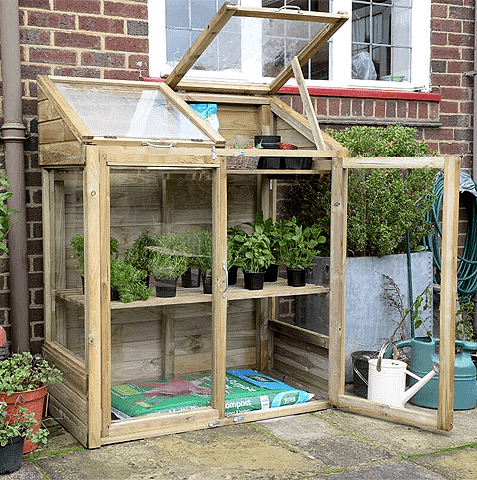

Mini greenhouses
These tend to be lean-to greenhouses or freestanding half-height greenhouses that provide growing room for those with small gardens or even balconies. These small greenhouses are also ideal for those just starting their journey into grow your own gardening with various compact greenhouse sizes being available.
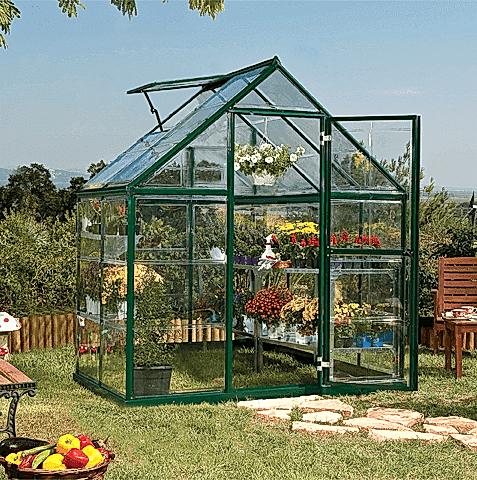

Mid-sized greenhouses
Mid-sized greenhouses: 6x4 and 6x8 greenhouses are the most popular greenhouse sizes for the average gardener who enjoys growing tomatoes, peppers and cucumbers or who enjoys growing from seeds and plug plants before transplanting them out to their garden borders.
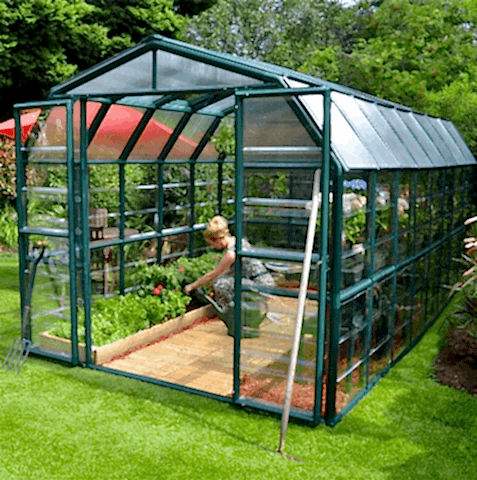

Expansive greenhouses
For gardeners looking for more space, explore our larger greenhouse sizes. 10x12, 8x20 and 10x20 are just a few of our largest greenhouses for sale. They offer the professional grower or keen horticulturalist plenty of space for growing and overwintering. These top rated greenhouses even have enough room for greenhouse shelving, greenhouse ventilation, garden furniture, etc.
For those requiring more space, explore larger greenhouse sizes available in our collection.
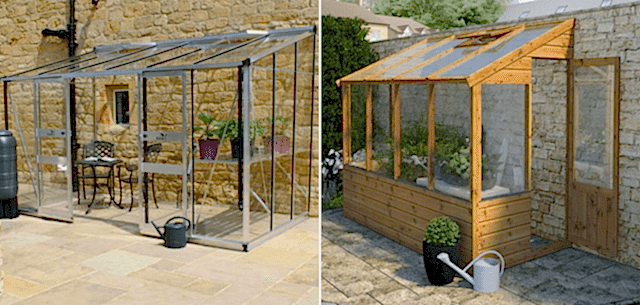

Lean-To Greenhouses
Lean-to greenhouses are designed to make the most of your available garden space by sitting against another object, such as a fence or wall. They usually come with a pent roof, which gradually slopes downwards from a high point at the back of the greenhouse.
Lean-to greenhouses are far more versatile than you might think. Those with a back panel can be positioned anywhere in the garden, while larger models are often suitable for use as conservatories too.
Greenhouse combi-sheds
If you are looking for some storage capacity as well as a greenhouse, consider one of our innovative greenhouse combi-sheds (or Potting Sheds). These cater to both your cultivation needs as well as storage requirements in a "two in one", elegant solution. These hybrid types of greenhouses are much sought after among gardeners.
With greenhouse prices being an important consideration when buying a greenhouse, it is nice to receive the inbuilt extra storage functionality as well. Our greenhouse combi-sheds selection includes various models from 6x6 to 10x10, these include the 10' x 8' Traditional Shiplap Wooden Potting Garden Shed with 8' Gable (3.05m x 2.43m).
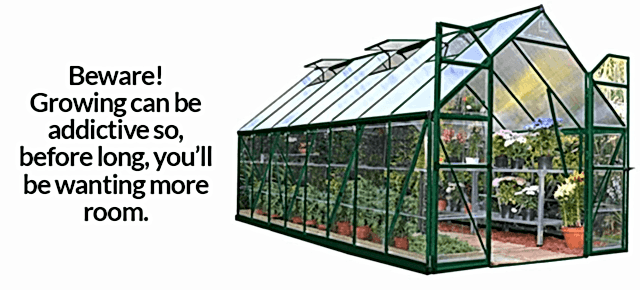

What greenhouse size is best for your space?
Of course, you will be guided by what room you have available in your garden.
As a greenhouse relies on sunshine, you will want to choose an area which receives the majority of sun over the day. Remember you will need space around the greenhouse for light and maintenance.
Beware! Growing can be addictive so, before long, you’ll be wanting more room, so consider your long-term requirements carefully when you buy a greenhouse.
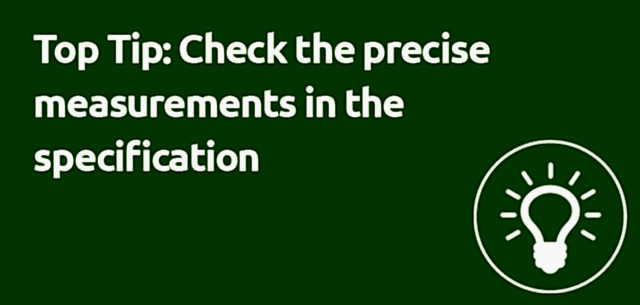

Important Advice: Always verify the exact greenhouse dimensions in the product specifications.
Greenhouses listed as 6x4 or any other greenhouse size might not adhere strictly to those greenhouse dimensions, as they are approximate.
When you buy a greenhouse, ALWAYS refer to the specification guide on the product page for detailed measurements. Our friendly customer service team in the UK is on standby for assistance.
Decision 2: Greenhouse frame material
Exploring greenhouse types and understanding the benefits of greenhouses are essential steps before considering greenhouse assembly. Whether you are leaning towards an aluminium greenhouse frame for its durability and low maintenance or a wooden greenhouse frame for its aesthetic appeal, each option offers unique advantages to enhance your gardening experience.
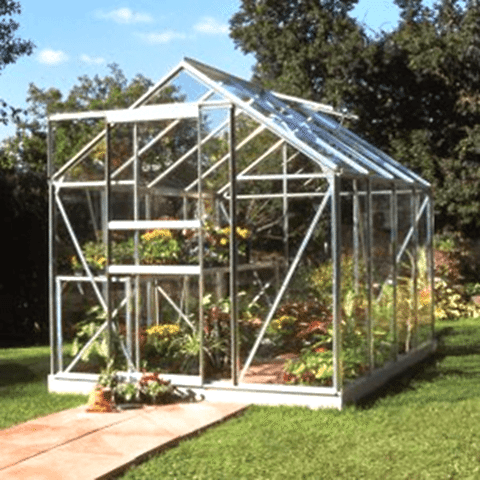

Aluminium greenhouse frame
The vast majority of greenhouses have aluminium frames. Aluminium is a strong but also lightweight metal which is also rust-resistant, so requires very low maintenance. Aluminium frames will often have a powder-coated finish. Many of our aluminium greenhouses for sale have integral gutters as part of the design so you can connect your own water butt.
Our aluminium greenhouses are manufactured by Halls and Palram Canopia, top-quality brands that are well-known in the UK. Guarantee lengths vary between five and fifteen years, depending on which greenhouse you buy. Look out for extra framing on the larger models.
Shop aluminium greenhouses
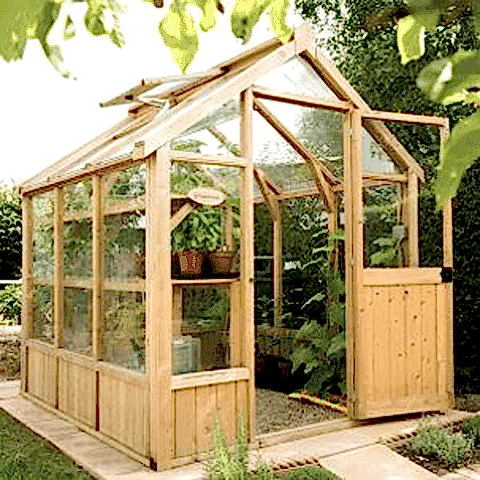

Wooden greenhouse frame
Wooden frame greenhouses are a beautiful garden feature in their own right. The natural timbers make them a superb choice for blending into your garden. Choose from either tongue & groove or shiplap tongue & groove cladding, which provides the sturdiest of wooden frames. Our wooden greenhouses are manufactured by Forest Garden and Coppice, two of the most highly respected brands in the UK market.
Look out for pressure treatment and 15 year guarantees as this will mean you won’t have to treat the greenhouse for over a decade – leaving you more time to enjoy nurturing your plants. A dip-treated greenhouse will have a 10 year guarantee and will need annual treatment.
Shop wooden greenhouses
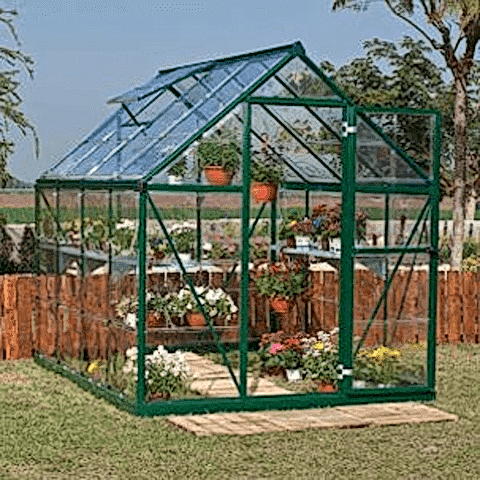

Colours
You do have a choice when it comes to the colour of your greenhouse. Aluminium greenhouse frames can come in their natural silvery metal or with a powder-coated finish in traditional green, modern grey or striking black.
Wooden greenhouses can be painted or stained in a whole host of colours. This will take time, due to all the greenhouse glazing to avoid, but can produce a striking result.
Shop coloured greenhouses
Decision 3: Greenhouse glazing
Understanding the cost of a greenhouse, as well as greenhouse features and the different types of greenhouses is crucial before making an informed decision. Whether you opt for the clarity of toughened glass or the versatility of polycarbonate panels, each glazing option offers distinct advantages that cater to various greenhouse needs and preferences.
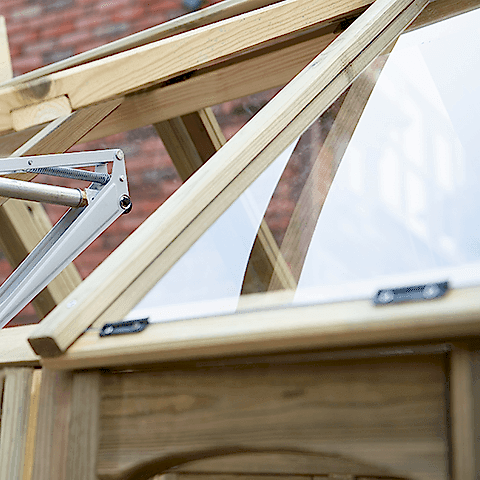

Toughened glass
Because standard horticultural glass is only 3mm and shatters into sharp shards, most manufacturers will offer an upgrade to toughened glass. Toughened glass or safety glass is designed to break into larger, safer pieces and is a feature in the best greenhouses.
Offering the highest light transmission, glass lets through around 90% of the light which supports your plants’ growth. It is direct light, rather than diffused or scattered. This is helpful for regions that tend to have lower temperatures even in the height of summer. Be aware that – for most regions - shading will be essential.
Glass greenhouses are not as well insulated as polycarbonate ones as they heat up and cool down quickly. You will require a greenhouse heater as well as shading. Also, glass requires regular cleaning throughout the year. However, as long as it is not broken, durable greenhouse glazing can last forever.
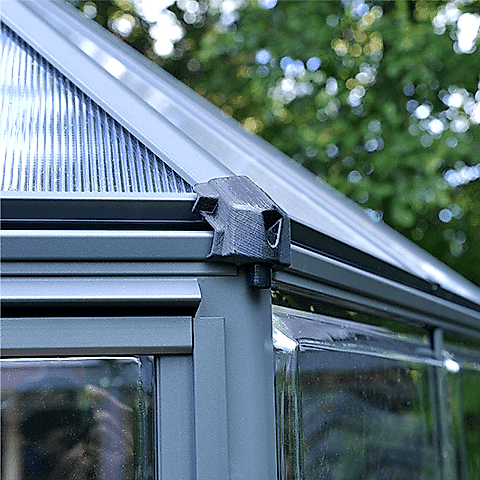

Polycarbonate panels
Polycarbonate is the most common form of greenhouse glazing. It is a specialist form of plastic which, when used in a greenhouse, is UV-protected to prevent it from yellowing or becoming brittle. The superior brands of polycarbonate will also break down harmful UV rays to protect you and your plants.
Another benefit of glazing a greenhouse with polycarbonate is that, as a light material without sharp edges, it is easier, safer and quicker to install. Though it is prone to scratching, it only needs cleaning once or twice a year so is a much lower maintenance option than glass.
Polycarbonate diffuses the light. Clear panels will diffuse light less than frosted panels and are best for germinating seeds and nurturing any plants you later want to move outside. Clear panels also provide views of your garden while you are working inside.
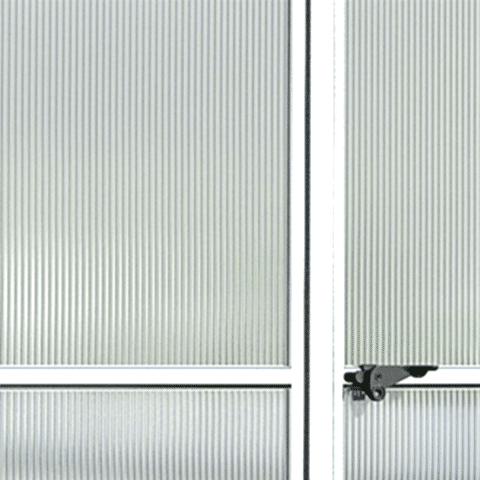

Frosted Polycarbonate panels
Frosted or opaque polycarbonate diffuses the light even further than clear polycarbonate. It is better for growing taller plants and vegetables you want to mature inside the greenhouse. The more diffused light will result in plants that aren’t so “leggy” having stretched to find the hot spots of direct light. Diffused light wraps around plants and reaches lower leaves as well as top leaves.
Polycarbonate naturally retains more heat than glass as glass is very quick to heat up and cool down. Look out for twin-wall polycarbonate as this provides the best insulation in the winter. The twin-wall greenhouse design creates a buffer of air pockets between the greenhouse glazing that decreases heat loss.
Be aware that standard polycarbonate only has a life span of around 10-12 years. Also, when buying a greenhouse consider a hybrid greenhouse which combines frosted and clear panels.
Decision 4: Greenhouse doors
Choosing options for greenhouse assembly, understanding the cost of a greenhouse, and choosing between the styles of greenhouses are important decisions when selecting greenhouse doors.
Whether you are considering single or double doors, evaluating their security features, or opting for space-saving sliding doors, each choice plays a significant role in the functionality and accessibility of your greenhouse.
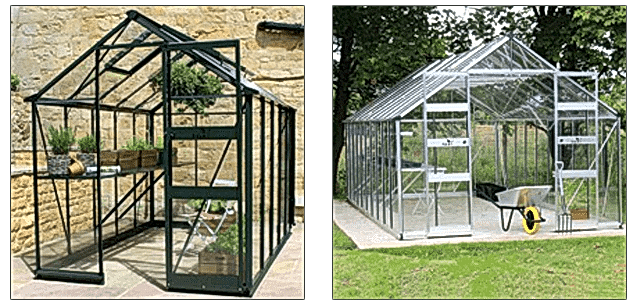

Single or double greenhouse doors
This decision can be pre-determined for you based on the greenhouse size. However, if you do have a choice consider what you will be moving in and out. Are you likely to have large flowerpots? Tall plants? Need to get a wheelbarrow in and out? Bear in mind when buying a greenhouse that double greenhouse doors may take up “wall” space.
Security
When choosing a greenhouse, it may be important to consider security. Though greenhouses do not often contain highly valuable contents, you may – especially if your greenhouse is on an allotment – want to be able to secure your greenhouse door. This is usually done via a padlock through the holes of the handle though some models do come with a key-operated lock.
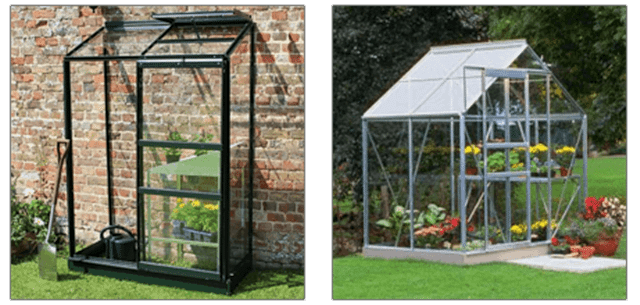

Sliding greenhouse doors
Some gardeners prefer a sliding door as it won’t swing open in the winds and is a space-saving feature.
Look out for zero-threshold greenhouse doors. These have no bar across the bottom, making it easier to manoeuvre items in and out and giving you one less thing to trip over.
Shop single door greenhouses
Shop double door greenhouses
Decision 5: Greenhouse air vents
Greenhouse air vents (roof windows) are important in your greenhouse for regulating temperature and creating the optimum growing conditions for your plants. Good greenhouse ventilation is important in combating fungal diseases. A greenhouse should have at least one roof vent. The larger the greenhouse, the more greenhouse air vents you will want.
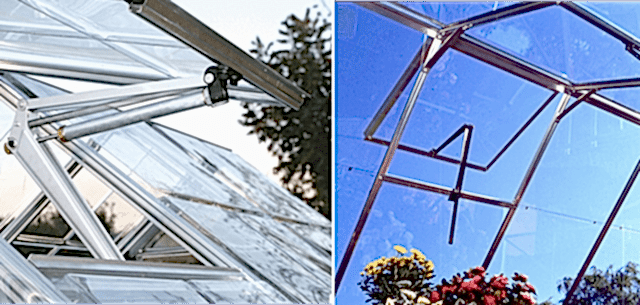

Look out for models with a louvre panel. This allows for fresh air to be drawn in at the bottom which will then rise and be released as hot air through the roof vent. Having greenhouse air vents on different levels maximises airflow and circulation throughout the greenhouse.
Look out for models which come with an auto-vent. This will gauge the temperature and open the vent once the heat increases. Auto vents can either have electric motors (some of which can be programmed) or use the expansion and shrinkage of a heat-sensitive material, such as wax, to move the piston.
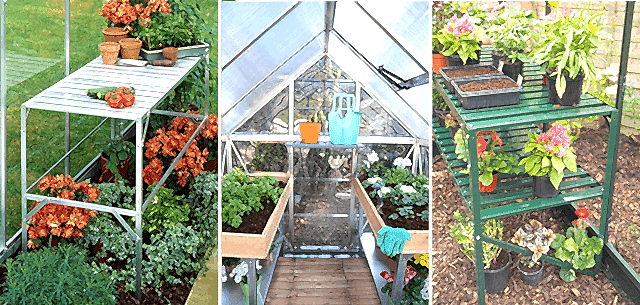

Greenhouse staging is the term for workspace in a greenhouse or shed. Full-width benching or a potting table is essential for potting up, planting seeds trays, etc.
Greenhouse shelving can also provide space for storing plants. Individual shelf sections allow you to leave space for tall plants. Wooden greenhouse racking adds a classic aesthetic appeal and durable solution for organising tools and plants.
Look out for seed tray stands that maximise space by offering tiers of storage for your seed trays.
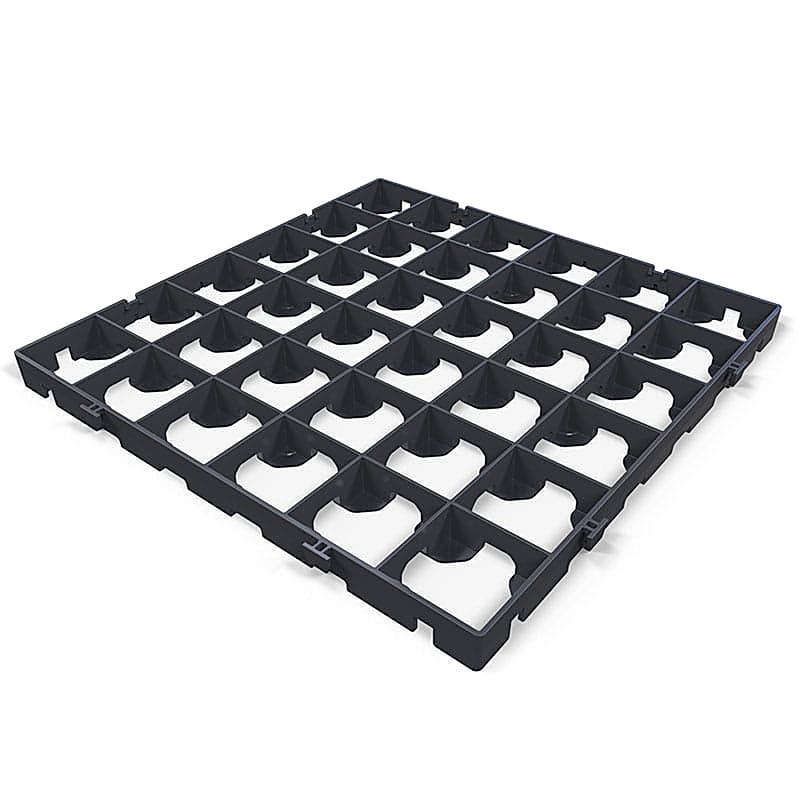

Plastic greenhouse bases
A plastic greenhouse base comes in a kit form consisting of a membrane and interlocking squares. For larger greenhouses, building a base for a greenhouse requires pea gravel to fill the squares. The greenhouse will then sit on the plastic squares. Using a plastic greenhouse base does not require a concrete surface and it can be placed straight onto a prepared, level grass area.
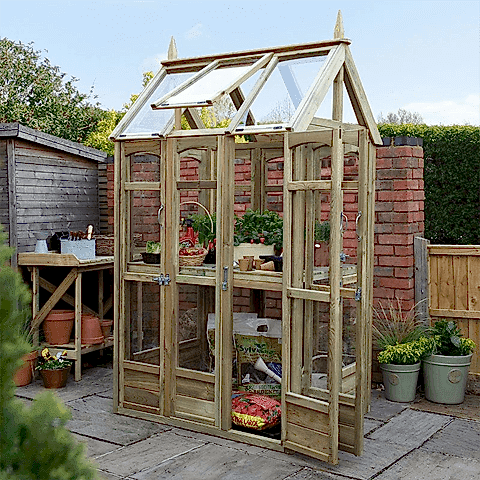

Full concrete greenhouse bases
You can use poured concrete or concrete slabs to create a solid, flat concrete base for a greenhouse – or you may have an existing level patio. If using concrete slabs, you can use shingle between slabs to space out the slabs which may be cheaper than buying a larger number of slabs. The shingle may also help drainage after watering plants.
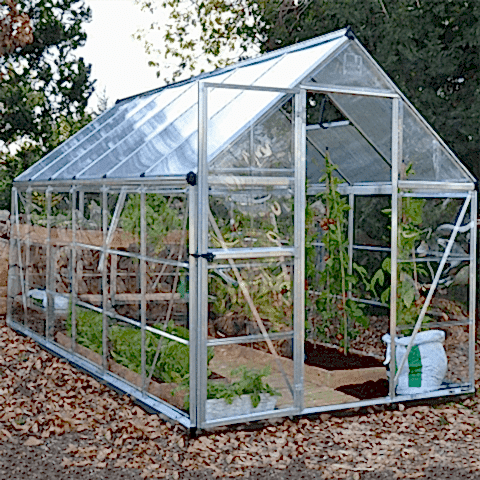

Perimeter Greenhouse Bases
You can use slabs or bricks to create a perimeter base. A line of slabs or sections of bricks is then placed down the middle of the interior as a pathway. This leaves direct access to soil for growing inside the greenhouse. You can choose to leave as much or as little soil exposed, as long as the perimeter is stable and unlikely to shift.
| Task | Cold Frame | Mini Models | Small Basic | Small Advanced | Large Basic | Large Advanced |
|---|---|---|---|---|---|---|
| Upfront cost | £50-£125 | £175-£500 | £300-£2,500 | Up to £4,500 | £400-£3,000 | Up to £5,500 |
| DIY installation | FREE | FREE | Less than £50 | £50-£100 | £100-£200 | £100-£200 |
| Professional installation *1 | N/A | N/A | Less than £100 | £75-£150 | £100-£150 | £150-£200 |
| Overall | £50-£125 | £175-£500 | £300-£2,600 | Up to £4,650 | £400-£3,200 | Up to £5,700 |
Notes:
*1 – Some of our greenhouses have the costs of installing a greenhouse included
Accessories and costs
The following greenhouse accessories are also all optional and available at additional cost:
- - Greenhouse heaters – expect to pay between £20 to £300
- - Greenhouse lighting – varies between £20 to £200 depending on the complexity of the solar lighting you are looking for
- - Greenhouse shelving - up to £30 for basic greenhouse shelving, with £100+ for more advanced greenhouse shelving (often modular in design)
- - Greenhouse ventilation - louvre vents are more basic and cost up to £50. Automated greenhouse ventilation systems save time but cost anywhere up to £300
Building permits and greenhouse planning permission
Expect prices to vary between local authorities, starting from £80. The price you pay will also vary based on the complexity of your greenhouse assembly. We would set an expectation that most greenhouses in back gardens will not require planning permission.
Planning permission for greenhouses
Greenhouse planning permission is not required in most cases. It is always wise to ask your local planning authority BEFORE buying and installing a greenhouse. If any of the following five circumstances apply, you MUST apply for planning permission:
- Visibility in the front garden - if the greenhouse is easily visible to those passing by your property
- Height and proximity to the boundary - if the greenhouse exceeds 8'3" in height and is located less than 2 meters from the property boundary
- Extensive use of garden buildings - if garden buildings occupy 50% or more of any part of the garden
- Heritage property considerations - if your residence is a listed building
- Sensitive locations - if your property is situated in a National Park or an Area of Outstanding Natural Beauty
The above is merely an overview. If you are in any doubt at all about planning permission for greenhouses, contact the planning department of your local authority.
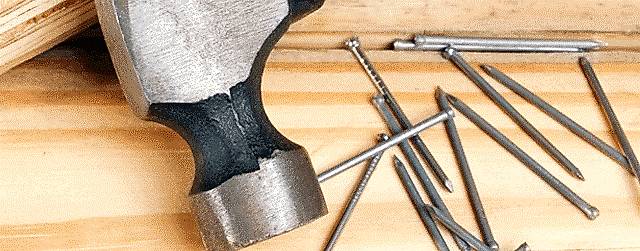

Installing a greenhouse
A few of our larger Coppice and Forest Garden Wooden Greenhouses for sale offer an installation service. Though not all provide greenhouse assembly services at this time, all our greenhouse manufacturers provide comprehensive greenhouse assembly instructions and customer support lines.


What are the delivery lead times?
We offer a pick-a-day delivery option for many items, allowing you to choose your preferred delivery date before making a purchase, as indicated on the product page. For products without this option, refer to the lead times listed for each item, which specify when it will be ready for dispatch.
Following this, the manufacturer will contact you to schedule a delivery date with you. Please note, any modifications to your order after payment may affect your delivery date, so ensure your order is complete before finalising.
Are there any delivery costs?
Considering greenhouse prices, free delivery is available for almost all products when buying a greenhouse. However, delivery to certain remote postcodes may involve surcharges, even if free delivery is offered to other areas. Employ our postcode checker to confirm if we deliver to your location and to ascertain any additional fees, which may be payable.


Should you need further assistance or have any additional questions regarding what to look for when buying a greenhouse for sale, do not hesitate to contact our friendly expert Customer Service Team based in the UK. We are always eager to assist when you dial 0333 003 0515. We can also be contacted by email using the form on our contact page. Also, speak to us in real time using live chat, this is available through the app icon, which is located at the bottom left of any page.





